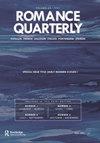Yves Navarre. About a postmodern epistolary writing
IF 0.2
3区 文学
0 LITERATURE, ROMANCE
引用次数: 0
Abstract
Abstract Yves Navarre's literary work is one of the greatest materializations of epistolary writing in postmodern literature. This article aims to analyze the different elements and procedures through which the epistolary matter becomes a practice of postmodern writing that continues to evolve throughout his prolix literary œuvre. First, the epistolary writing of fictional characters becomes an element of the renarrativization that participates in processes of discontinuity: a progressive fragmental writing—from his first novel Lady Black (1971) to the last Dernier dimanche avant la fin du siècle (1994)—and the hybridization with diaristic writing and literary metadiscourse—Le Petit Galopin de nos corps (1977), Kurwenal ou la Part des êtres (1977), Le Temps voulu (1979), Romances sans paroles (1982). Besides, these same practices are brought into the autofictional space, where the possibilities of hypertextuality are further deepened by quotation, intertext and metadiscourse—Biographie (1981), Romans, un roman (1988). Finally, the two spaces converge in an auto/alter-fiction in which postmodern diversel materializes through experimentation with alterity, giving rise to récits indécidables—L’Espérance de beaux voyages (1984), La terrasse des audiences au moment de l’adieu (1990). Throughout his entire literary work, and in all the aforementioned spaces, the abundant metadiscourse about epistolarity enables a postmodern phenomenology of epistolary activity.伊夫纳瓦拉。关于后现代书信体的写作
摘要伊夫·纳瓦拉的文学作品是后现代文学中最伟大的书信体作品之一。本文旨在分析书信体成为后现代写作实践的不同要素和过程,并在其冗长的文学作品œuvre中不断发展。首先,虚构人物的书信写作成为再叙事化的一个元素,参与了不连续的过程:一种渐进式的碎片式写作——从他的第一部小说《黑夫人》(1971)到最后一部《丹尼耶·迪曼切·阿凡达》(1994)——以及日记式写作和文学元话语的混合——《军团的小Galopin》(1977)、《Kurwenal ou la Part des êtres》(1977)、《Le Temps voulu》(1979)、《无假面浪漫》(1982)。此外,这些同样的实践也被带入了自我虚构的空间,在这里,超文本性的可能性通过引用、互文和元话语进一步深化——传记(1981),罗马人,非罗马人(1988)。最后,这两个空间在一部自动/另类小说中汇合,后现代的多样性通过对另类的实验得以实现,产生了“无法改变的人生”——《旅行的人生》(1984)、《告别时刻的观众》(1990)。在他的整个文学作品中,在上述所有空间中,关于书信的丰富元话语使书信活动的后现代现象学成为可能。
本文章由计算机程序翻译,如有差异,请以英文原文为准。
求助全文
约1分钟内获得全文
求助全文
来源期刊

ROMANCE QUARTERLY
LITERATURE, ROMANCE-
CiteScore
0.30
自引率
50.00%
发文量
18
期刊介绍:
Lorca and Baudelaire, Chrétien de Troyes and Borges. The articles in Romance Quarterly provide insight into classic and contemporary works of literature originating in the Romance languages. The journal publishes historical and interpretative articles primarily on French and Spanish literature but also on Catalan, Italian, Portuguese, and Brazilian literature. RQ contains critical essays and book reviews, mostly in English but also in Romance languages, by scholars from universities all over the world. Romance Quarterly belongs in every department and library of Romance languages.
 求助内容:
求助内容: 应助结果提醒方式:
应助结果提醒方式:


